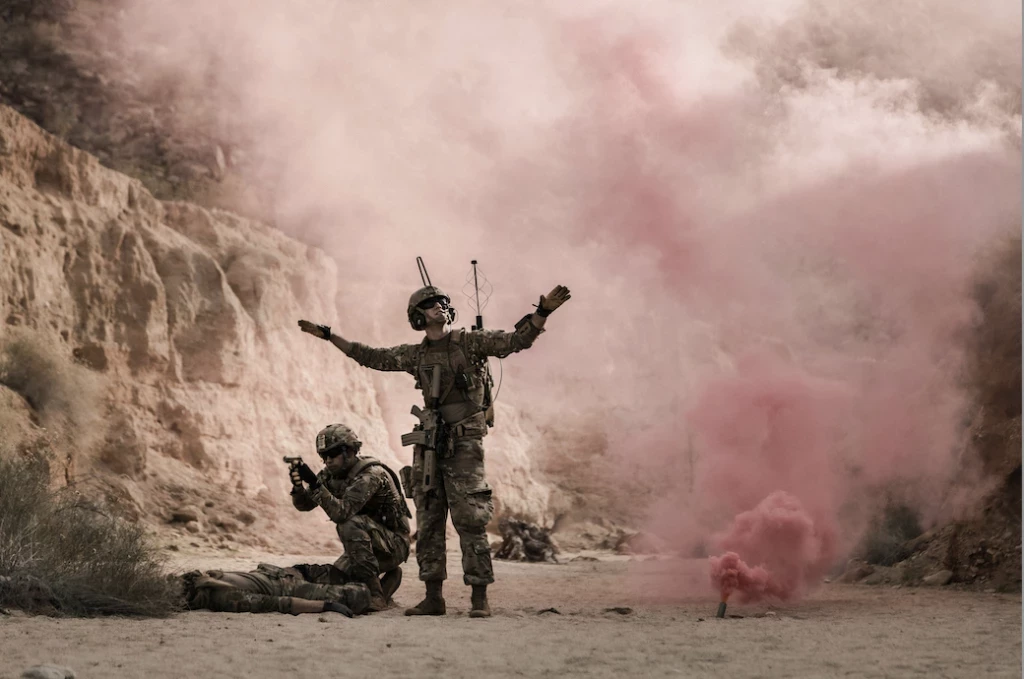Aegis Ashore anchors ballistic missile defense from new base in Romania
Add bookmarkReprinted with permission of Seapower, the official magazine of the Navy League of the United States.
The Navy’s newest “ship” has arrived at the service’s newest homeport … sort of. The Aegis Ashore Missile Defense System (AAMDS) now is up and running on U.S. Naval Support Facility (NSF) Deveselu, Romania, several hours west of the capital of Bucharest. Aegis Ashore is the land-based component of the Aegis Ballistic Missile Defense system.
NSF Deveselu, the first overseas naval base to be established in decades, sits in open country on the runway of a former Soviet bloc air base. The deckhouse can be seen from miles away. Aegis Ashore is a tenant command of the U.S. NSF, which is a tenant of the Romania Baza Militara 99 Deveselu. The turnover from the Missile Defense Agency to the operational commander, commander, U.S. Sixth Fleet, took place during a ceremony at the Romanian Ministry of Foreign Affairs on Dec. 18.
“The Aegis Ashore system can now function,” the Missile Defense Agency’s director, Vice Adm. James D. Syring, said at the ceremony. “Between now and the summer, military operators will train and conduct exercises and additional testing, readying for a NATO initial operational capability, or IOC, declaration for the Warsaw Summit in July.”
“I took the nod and the salute, and we declared technical capability demonstration,” Vice Adm. James G. Foggo III, who commands U.S. Sixth Fleet, told Seapower. “Now we’re integrating all the procedures and the people into the NATO BMD [ballistic missile defense] architecture for Europe.”
“This system is only meant to counter threats originating from outside Europe,” U.S. Ambassador Hans Klemm said at the ceremony. “It is not, I repeat, not directed at Russia, nor does it have the capability to threaten Russia. We have explained this to Russia on numerous occasions. We have also offered to work with Russia to help alleviate their concerns and, if they desire, to ensure the safety of all our citizens from ballistic missiles originating from outside the Euro-Atlantic sphere.”
Notwithstanding the nuclear deal with Iran, and the lifting of international sanctions, the intelligence community has estimated that the threat from Iran’s short and medium-range ballistic missiles has been developing more rapidly than previously projected, while the threat of potential Iranian intercontinental ballistic missile (ICBM) capabilities has been slower to develop than previously estimated, according to a fact sheet from the U.S. Embassy in Bucharest.
The Aegis Ashore deckhouse looks like that of an Arleigh Burke-class guided-missile destroyer. It was first constructed at Moorestown, N.J., for testing, then disassembled and the prefabricated pieces and 900 tons of steel, in 156 40-foot containers, were shipped to Romania.
“We tested it, and then unbolted it, brought it across on a ship, and erected it in a wheat field in Deveselu,” Foggo said.
“This odd-shaped deckhouse building is filled with the latest technologically and highlights the adaptive part of European Phased Adaptive Approach [EPAA],” he said.
The EPAA is the U.S. contribution to NATO BMD. Its purpose is to protect European NATO allies, and U.S. deployed forces in the region, against current and emerging ballistic threats from the Middle East. EPAA is being implemented in phases in order to be adaptable and flexible, and to include evolving BMD technology to counter the growing BMD threat.
In addition to Aegis Ashore, the NATO BMD architecture includes the Transportable Radar Surveillance System in Turkey; a command-and-control network operated from Ramstein Air Base, Germany, by the 603rd Air and Space Operations Center; and the BMDcapable destroyers forward deployed to Rota, Spain.
The Aegis Combat System was developed in the 1970s to defend ships and battle groups against air, surface and subsurface threats. The Aegis system has been updated many times since the lead ship, the guided-missile cruiser USS Ticonderoga, was commissioned in 1983.
Aegis Ashore incorporates the Navy’s proven and flexible Aegis BMD capability — the latest Baseline 9 version — with its SPY-1 radar, multimission signal processor, Mk 41 Vertical Launch System, and command, control and communications processors. It also has the capability to launch the Standard Missile-3 Block IA, Block IB, and, beginning in 2018, the Standard Missile-3 Block IIA.
There are differences, of course. It does not move, and it is not surrounded by the sea and its harsh environment. The launchers are not located fore and aft of the deck house, as on a ship, but are some distance away. But even though it is not sailing, it has the same ship’s gyro system, so the system can receive the required heading input. The masts and antennas are located in the same place topside because those positions have al ready been proven to work, so reengineering locations was not needed.
Working on the equipment is not limited by the cramped confines of a surface combatant — so there is more room to access and maintain the equipment — something the technicians appreciate. While ships can be moved, and be placed in a specific location along a ballistic missile threat axis, they cannot stay there indefinitely.
“Aegis Ashore provides fixed and continuous operation — 24 hours a day, seven days a week, 365 days a year,” said William Blair, Raytheon’s vice president of business development for Air and Missile Defense Systems.
[inlinead]
“A ship may pull into port, but the Aegis Ashore facility never goes off duty,” said Capt. Jeff Wolstenholme, who has command of Task Force 64, responsible for the Navy’s afloat and ashore BMD mission in the theater.
A second Aegis Ashore site is being established at the Redzikowo Base in Gmina Słupsk, Poland, which should be operational in 2018 Capt. Jim Craycraft, the NSF commanding officer, is responsible for the host nation military engagement, community relations, security, utilities, facilities, housing and food service in support of the “Fleet, Fighter, Family.”
In addition to the Aegis Ashore crews, there is a sizeable security force, including Navy master-at-arms specialists, administrative specialists, logistics specialists, government service employees and contractors According to Craycraft, the temporary U.S. Navy Seabee-built Romanian huts and expeditionary containerized living units have been replaced with a new combined housing/dining facility, command security con trol facility, expeditionary medical facility, public works facility, fire station and other mission-support buil d ings. There’s even a small but growing Navy Exchange.
The dirt roads and muddy walkways have been re-placed by paved streets and sidewalks. With the spring will come the grass lawns and plantings, while the fertile farmland around base bursts into fields of wheat and sunflowers.
“We’re self-contained,” Craycraft said. The installation has a robust Morale, Welfare and Recreation program that provides opportunities for the Sailors to get off base and see Romania, Craycraft said. “This weekend, we have people going on a ski trip to Sinaia in the Carpathian Mountains. Our people enjoy the culture, history and hospitality of Romania. The adoption of the local Deveselu elementary school has provided great enjoyment for our civilian and military team,” Craycraft said. “It’s a unique opportunity for us to interact with foreign nationals as our host, as well as having an appreciation as a U.S. citizen of the strong bonds we have with our host nation.
“We represent the Navy’s newest installation, and the community of Deveselu is very proud of our partnership,” he said. “We have great appreciation for each other, both personally and professionally. We know the people from the Ministry of Defense, the Romanian Navy and the county and the town. We want to build great relationships with them and, from my perspective, they want to build great relationships with us.”
Cmdr. Drew Carlson is the AAMDS commanding officer. He has nine crews of 11 Sailors who man the site on a rotational basis. His command is located in the four-story deckhouse building that houses the major components of the Aegis Weapon System. AAMDS has a high percentage of senior personnel.
“We’re looking for proven performers who meet the screening requirements,” he said. “It is expeditionary duty in an austere location. Sailors need to be independent and motivated. As a small command, our bench is not very deep, but our talent pool is unsurpassed.”
According to Carlson, AAMDS watch teams are based in Dam Neck, Va., where they undergo an “academy” of predeployment preparations, complete with language training and cultural orientation from the Defense Language Institute, before coming to Romania for their six-month rotation. The three-year duty tours feature a stable deployment schedule.
“Aegis Ashore is slightly different in that the command element is 100 percent of the time forward, with two-thirds of the command in CONUS [the continental United States] at Dam Neck in various stages of inter-deployment activity,” Carlson said.
Most administrative requirements for the command and the detachment are handled by the Fleet Introduction Team, an eight-person team under PMS 339 that supports personnel and administrative actions for the command.
Principal efforts at Dam Neck are the reception, integration, training and deployment of the 11-person watch teams to Romania. Currently, watch teams Blue 1 and 2 are on station, undergoing Aegis Ashore Team Training and Aegis Ashore Academy respectively.
The crews get individual and team training. Highfidelity training at Dam Neck takes place in a detailed replica of the Aegis Ashore Combat Information Center.
Before deploying, the crews are evaluated by Tactical Training Group Atlantic and certified for deployment to Europe by U.S. Fleet Forces Command. Following a recent certification, watch team White 3 arrived in Romania to relieve watch team Red 3 in early February.
“We’re working side by side with industry partners — Lockheed Martin, Raytheon and BAE Systems, to name a few — and with Navy counterparts at Naval Surface Warfare Centers, SPAWAR [Space and Naval Warfare Systems Command], and NAVSSES [Naval Ship Systems Engineering Station] conducting weapon system and C4I [command, control, computers, communications and intelligence] system installation,” Carlson said. “Those partnerships continue after Navy acceptance of the system from MDA and operations begin in earnest.”
Wolstenholme said the four Rota, Spain-based Forward Deployed Naval Forces BMD ships and Aegis Ashore together are developing a high level of expertise.
“We’ve built a cadre of BMD experts,” he said. “The technology is impressive, but like anything in the U.S. Navy, Sailors are the true heart of the mission,” Foggo said.
Operations Specialist 2nd Class Tura Hudson is the most junior Sailor assigned to Aegis Ashore, but she maintains the link picture all the way up into the exoatmosphere.
“I love doing this,” Hudson said. “I enjoy sitting at this console, and bringing up the picture, and talking to everyone else out there in the fleet. If there’s a launch, I’ll see it. And we’ll kill it.”
Hudson does not have previous Aegis experience. “I was on an amphib, the Mesa Verde. This is my first BMD assignment, so coming here I had to learn something brand new. The training was very detail-oriented and intense,” she said. Hudson said her friends back home in Philadelphia don’t know how important her job is. “I don’t talk about what I do. I just tell them I look at radar screens,” she said. “It’s my job to use this radar to initially detect a ballistic missile and track it, whether we pass it off or take the shot,” said Fire Controlman 1st Class Christopher Mays, the 2015 AAMDS Sailor of the Year. “I’ve been a SPY tech for about 18 years, and I’ve been on six ships. But coming here, I’ve learned so much. It’s been a great experience, and I’m furthering my knowledge. The best part is the new equipment. This is the cutting edge — the best we have to offer.”
The cutting edge is partly what draws Sailors to sign up for duty in Romania. But the leadership is clear that technology is only a part of the capability.
“Aegis Ashore is no different in this regard from other advanced Navy weapon systems: the true warfighting capability comes from our Sailors,” Carlson said. “‘Men mean more than guns in the rating of a ship,’ [to quote John Paul Jones] and at Aegis Ashore, our exoatmospheric warriors bring more capability than just what the weapon system provides.”
Carlson’s crews are excited to be a part of something new, and having the very latest equipment. He likens the journey from the concept of Aegis Ashore to reality at Deveselu to the Lewis and Clark Corps of Discovery 1804-1806 expedition.
“They knew where they were going, but they weren’t exactly sure how they were going to get there. We are pioneering in the same sense, and we have to get it right,” Carlson said. “We have to keep people engaged for a mission we don’t want to do, but if we do wrong could mean so much. Our allies and partners need this capability, and the Navy’s proven system and talented cadre of missile defenders can deliver.”
According to Col. Razvan Bratulescu, commander of the Romanian 99th Military Base, working together have been challenging and rewarding at the same time.
“This has been a sharing of experience, the opportunity to learn from each other to understand the similarities and the differences between our cultures,” he said.





















